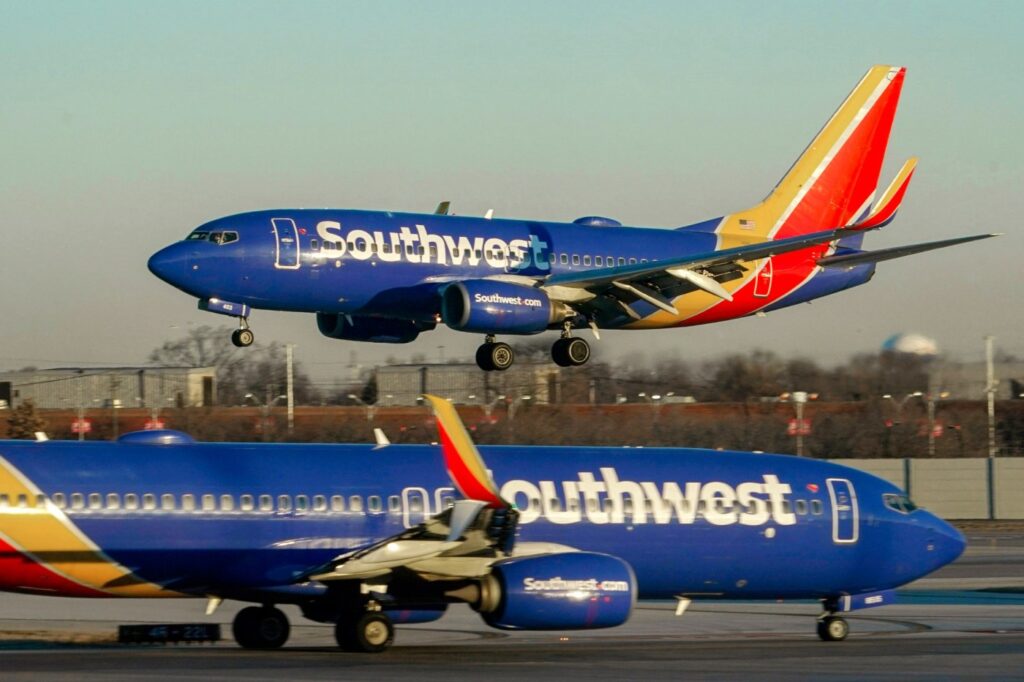
By Mary Schlangenstein | Bloomberg
Southwest Airlines Co. is slowing growth, ending service at four airports and offering voluntary leaves to address “significant challenges” stemming from reduced deliveries of Boeing Co. planes.
Southwest is now set to get 20 Boeing 737 Max 8 planes in 2024, down from 46 previously, the airline said in a statement Thursday that also included worse-than-expected quarterly results. It’s the third such reduction by the planemaker since January.
The shares tumbled 11% shortly after the start of regular trading in New York, the biggest intraday decline in six weeks.
“We are reacting and replanning quickly to mitigate the operational and financial impacts while maintaining dependable and reliable flight schedules for our customers,” Chief Executive Officer Bob Jordan said in the statement.
Also see: Boeing says no 787 safety risk after whistleblower raises troubling claims
The steps illustrate the toll that the Boeing crisis is having on one of its leading customers — one known for flying an all-737 fleet.
Southwest earlier stopped hiring for multiple work groups, including pilots and flight attendants, and said it would end the year with 2,000 fewer employees than in 2023 as a result. With Boeing slowing output because of manufacturing-quality concerns, Southwest has been “urgently” focused on finding more ways to lower costs and improve efficiencies, executives have said.
Southwest will end operations at Houston’s George Bush International Airport, Bellingham International Airport in Washington, Syracuse Hancock International Airport in New York and Mexico’s Cozumel International Airport on Aug. 4. The carrier also will “significantly restructure” other markets, including reducing capacity at O’Hare International Airport in Chicago and Hartsfield-Jackson International in Atlanta.
‘Below trends’
Flying capacity growth in 2024 will decline to 4% over 2023 from a 6% increase planned previously, and expansion beyond this year will be “at or below macroeconomic growth trends,” Southwest said. Revenue for the year will increase in the high single digits, versus a prior prediction of double-digit growth year over year.
Costs to fly each seat a mile in 2024 will rise as much as 8% this year from prior estimates for 5.5% to 7%. The carrier will end the year with 802 aircraft, down from 814 as originally planned, and capital spending will drop to about $2.5 billion from as much as $4 billion previously. Current plans call for aircraft seats and trip frequencies to decline in both the third and fourth quarters compared with 2023.
“The 2024 cost outlook is largely consistent with expectations despite Max delivery shortfall,” Raymond James analyst Savanthi Syth said in a note. “However, the revenue performance was somewhat disappointing.”
Steps taken and planned by Southwest should contribute $1 billion to $1.5 billion to 2024 pre-tax profits, the airline said.
There’s no assurance that Boeing will meet the reduced aircraft delivery schedule, Southwest said. The airline will keep flying more of its older planes this year to help close the gap from the Boeing delivery decline, retiring just 35, down from earlier plans for 49.
Boeing has been forced by regulators to cap output of its bestselling Max model, leaving many customers short of much-needed aircraft at a time when carriers are expecting another year of record travel and demand for fuel-efficient jets remains high.
The planemaker’s year has been dominated by fallout from a near-catastrophic accident on Jan. 5, when a fuselage panel broke off an Alaska Airlines 737 during flight. Boeing remains under scrutiny by federal safety regulators and the US Justice Department.
Southwest had an adjusted first-quarter loss of 36 cents a share, wider than the 31-cent deficit expected by analysts. Revenue was $6.33 billion, also missing estimates for $6.42 billion.
Capacity will rise 8% to 9% year over year this quarter heading into the busy summer travel season. Non-fuel unit costs will increase as much as 7.5%, compared to a 3.9% rise expected by analysts. Revenue per seat-mile flown will drop 1.5% to 3.5%, while analysts expected growth of 0.16%.
Southwest last month said it had given up on getting any of its long-awaited 737 Max 7 aircraft this year after delays in receiving federal certification of the model. Around the same time, United Airlines Holdings Inc. told Boeing to stop making Max 10 jets for the carrier because its delivery timeline was so uncertain, and later agreed to take some planes made by Airbus SE.
Related Articles
Airlines now must pay automatic refunds for canceled flights
As Boeing faces new scrutiny, families of Max crash victims still in limbo
Only one North American airport makes list of world’s best
Boeing says no 787 safety risk after whistleblower raises troubling claims
Airbus pulls further ahead as Boeing struggles
